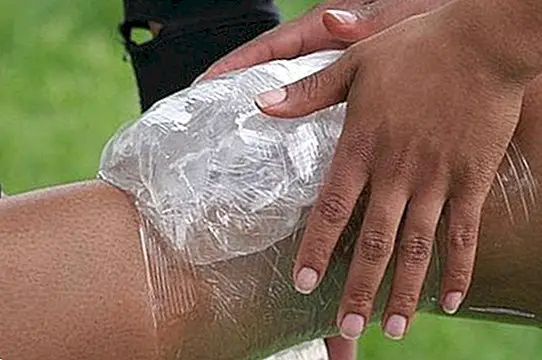Which mushrooms are edible, how to clean and preserve them
The time of the mushrooms, undoubtedly one of the most characteristic, well-known and traditional autumn foods, an extremely beautiful and special season in which other equally popular foods are also common, such as figs, chestnuts or persimmons.
In fact it is a pleasure at this time to take a walk through the countryside, spend a day of cold and pleasant rain and walk looking for them among the trunks of the trees and in the most humid lands. But they have a particularity that is more than important: we must know which ones are edible and which ones we can actually catch, since some of them can be very toxic and dangerous for our health.

From a nutritional point of view there is no doubt that mushrooms stand out for their high protein content of high biological value, which means that they provide the majority of essential amino acids and also a good amount of minerals, such as iron, potassium, phosphorus, manganese, zinc, sulfur, boron and chlorine.
The best edible mushrooms
Chanterelle (Cantharellus cibarius)
It is an edible mushroom very appreciated. The underside of his hat is covered by spaced folds. It is easily identifiable because it presents a uniform yellow color, its folds (or pseudoláminas) are very thick and the foot is shown in continuity with the hat. It is well known and easily distinguishable by its fruity aroma, reminiscent of apricot.
It is possible to confuse it with two toxic species: Omphalotus Y Omphalotus illudens, although these are characterized by presenting a larger size and usually grow in groups on stumps of old trees.

Tab on the chanterelle
- Family: Cantharellaceae.
- Other names: San Juan mushroom, cabrilla.
- Epoch: between the beginning of summer and autumn.
- Where to find it ?: Under coniferous and planifolios.
- Sheets: forms spaced folds, sulfur yellow with orange tones.
- Meat: whitish or yellow. Its smell reminds the apricot.
- Hat: flattened diameter and then funnel-shaped, with yellow sulfur color.
Mushroom of Saint George (Calocybe Gambosa)
Unlike other more autumnal mushrooms, the St. George mushroom grows only in spring. It has a strong flavor, although it is a mushroom that has a lot of meat. Its blades are tight, and appears above all in calcareous soils, forming witches' circles among the grass.
It can be confused with deadly white amanites, especially when it is collected under the trees. In autumn it can be confused with Entoloma lividum, whose hat is pale and its plates, yellow at the beginning, turn red.

Card about the mushroom of St. George
- Family: Tricholomataceae.
- Other names: Spring mushroom, fine mushroom, Tricholoma georgii.
- Time: mainly in spring.
- Where to find it ?: under planifolios and conifers, between the clearings of forests, meadows and grass of the meadows.
- Sheets: tight, creamy and yellowish.
- Meat: white, firm. Its smell is reminiscent of flour.
- Hat: fleshy, whitish or whitish gray with cream tones. It can measure from 5 to 10 centimeters in diameter.
Bold (Tricholoma Terreum)
It appears in groups under the pines, above all in calcareous soils. It is easily collected because it appears in abundance. Its smell is very reminiscent of the aroma of the grass when it is cut.
It can be confused with other species belonging to the same family, which are all equally edible.

Tab on the bold
- Family: Tricholomataceae.
- Other names: mouse mushroom.
- Time: throughout the autumn and early winter.
- Where to find it ?: under spruces and pine trees, in limestone terrains.
- Sheets: grayish or dirty white.
- Meat: smell reminiscent of cut grass, it is whitish and brittle.
- Hat: grayish, fibrous and conical, although it may have a pronounced central mamelon.
Edible ticket (Boletus Edulis)
It is one of the most popular and popular boletus. It is easily recognizable by its hat, with a brown color of an intensity that diminishes towards the edges. One of the most positive issues of this mushroom is that it can not be confused with any other toxic fungus.

Factsheet about the edible ticket
- Family: Boletaceae.
- Other names: Bordeaux mushroom, mushroom, pumpkin.
- Epoch: from summer to the end of autumn.
- Where to find it ?: under coniferous and planifolios.
- Prints: does not present Yes it has white pores that tend to be yellowish.
- Meat: very white, although it can also be brownish.
- Hat: smooth surface that is usually fat when it ages.
Black ticket (Boletus Aereus)
It is one of the most valued boletus, precisely because it is not very common.It has a dark brown hat, along with a tremendously wide foot and whitish pores. Its meat is very firm, hence it is highly valued gastronomically.
Although it is one of the most delicious mushrooms, and perfectly edible, some people can present allergic processes when they ingest it (although it is not common).

Tab on the black ticket
- Family: Boletaceae.
- Other names: head of black, tan ticket.
- Epoch: from late summer to early autumn.
- Where to find it ?: oak forests.
- Prints: does not present
- White meat.
- Hat: dark colored (blackish brown) and dry surface, may present shaded highlights.
Reticulated summer ticket (Boletus Aestivalis)
It is a mushroom characteristic of spring and summer, usually disappearing in autumn when the cold starts. It has a dry surface, while its hat has a rather uniform color. Depending on the environmental conditions it can have a length of between 5 to 20 centimeters, and a thickness of between 2 to 8 centimeters.
It can be confused with Tylopilus felleus, whose pores present grazed tones and its flavor is tremendously bitter.

Card on the summer reticulated ticket
- Family: Boletaceae.
- Other names: reticulated fungus, boletus reticulatus.
- Time: throughout the summer and autumn.
- Where to find it ?: Under forests of oaks, cork oaks, oaks and chestnuts.
- Prints: does not present Yes a whitish tubes that tends to change from yellowish tones to olive.
- Meat: white, with characteristic mushroom smell.
- Hat: dry and somewhat velvety surface, brown.
Amanita of the Caesars (Amanita Caesarea)
It is a mushroom easily distinguishable by its striking color, because when it is still very young presents an appearance that reminds a lot of an egg, whose membranous white volva tends to disappear to leave on sale a beautiful mushroom with an orange hat and in his foot what remains of the volva.
It can be confused with the Amanita muscaria (or false fake), which presents a hat decolorido because of the rains, and loses the remains of the veil.

Card about the amanita of the Caesars
- Family: Amanitaceae.
- Other names: oronja.
- Time: throughout the summer and autumn.
- Where to find it ?: Under forests of oaks, cork oaks, oaks and chestnuts.
- Sheets: yellow.
- Meat: white or something yellowish, with a fungal smell.
- Hat: orange carmine color with whitish remains belonging to the veil.
Wild mushroom (Agaricus campestris)
It is one of the most popular and known mushrooms, easy to find in meadows. The diameter of your foot tends to decrease when we approach its base, being this issue easily distinguishable.
It can be confused with the Agaricus xanthoderma, whose flesh yellows a lot (especially at its base), and which has a strong smell that is very reminiscent of sulfur.

Wild mushroom factsheet
- Family: Agaricaceae.
- Other names: field mushroom, Psalliota campestris.
- Period: Autumn.
- Where to find it ?: meadows and lawns.
- Sheets: intense pink color that turns chocolate brown.
- Meat: white or little pink.
- Hat: white or something paler.
How to clean the mushrooms
Once we have discovered that the mushrooms that we have picked are edible (If you have doubts, it is best not to do so to avoid greater health problems), it is convenient to clean them properly before cooking.
Unlike what you might think, it is not a good idea to rinse them under tap water, or even to soak them, as this will only help them lose flavor after cooking.
The best option to clean them is to use a knife, cutting the tip and scraping it to eliminate the different remains of soil and substrate that we can find in them.
When it comes to checking whether or not they have larvae, it is best to cut the hats, which is the most tasty part and where they tend to lodge.
It is also advisable to check if the mushrooms are in good condition. This will indicate both its color and its aroma: the color, for example, should be the characteristic color depending on the variety (the cantharellus mushrooms or the chanterelles tend to be orange), while the aroma is fruity.
And how can we keep the mushrooms better at home?
At the time of keep the mushrooms There are three ways that allow us to keep them until they are consumed, especially to prevent them from becoming damaged.
Of course, once well cleaned, you can choose between these three options:
- In a saucepan with boiling water, let them stand for two minutes to bring them to a boil. Add olive oil to some sterilized cans and keep them in them.
- In airtight bags, you can freeze them to maintain their virtues.
- Leave them dry. For this, you only need to thread them in a thread and put them in a dry but airy place.
Images | amuderick / colros / Harry-Harms / Tania.Paz / jrc8806n / kukipecurka / kukipecurka / kukipecurka / Petri Roponen (Flickr) This article is published for informational purposes only. You can not and should not replace the consultation with a Nutritionist. We advise you to consult your trusted Nutritionist.


